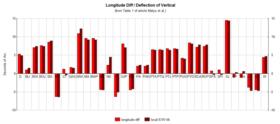
NavList:
A Community Devoted to the Preservation and Practice of Celestial Navigation and Other Methods of Traditional Wayfinding
From: Frank Reed
Date: 2015 Aug 18, 22:55 -0700
Don Seltzer, you wrote:
"I am confused by 'true prime meridian'. The PM is completely arbitrary..."
I tried to emphasize the difference in my last post, but obviously I'll have to try some more! An astronomically determined line of longitude (or latitude) has wobbles in it. It snakes back and forth across the globe. Never mind the number placed next to it identifying it as a specific longitude. This doesn't have to be the Greenwich meridian, and we could even consider this in a world with multiple "prime" meridians. Any of those meridians astronomically determined will be "wobbly" on the ground thanks to the small variations in the local vertical. These astronomically-determined coordinates are not "true" coordinates because calculations with those coordinates cannot yield accurate distances between points
I'm sure you understand what it means when I say that the vertical is tilted to the west by 40 seconds of arc for observers a dozen miles west of Bermuda and tilted 40 seconds of arc east for observers a dozen (-ish) miles east of Bermuda? But I ask you: tilted relative to what??
Don, you added:
"The new PM 100 meters east of the 19th century line is a mathematical convenience determined in the 1980's to minimize the errors as observed at different locations around the world."
Uh, says who?? I quoted a story something like that for a few years but I don't know where it originated. Turns out it was wrong. And if that were really the case then it's one helluva coincidence that the local east-west tilt of the vertical at those locations you're referring to just happens to be equal to the difference in longitude between the astronomically determined longitudes and the geodetic (TRUE) longitudes. Do you see that there is a very nice match between those in the table in the article? Here's my barchart version again:
In this barchart, each pair of bars represents one observing station. The lighter red bar indicates the difference between the astronomical and the geodetic longitude (in other words, GPS longitude ...but it could just as easily have come from precision ground surveys).
Frank Reed






